Santorini Splendor
By Armando Nicolas PJ

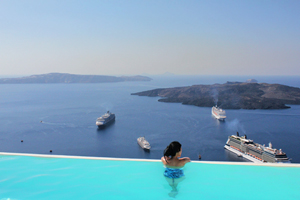 Stark rock cliffs and postcard-perfect houses on endless bluffs, quaint shops and donkey carts, the blue Aegean and fiery sunsets — the island's magnificence knows no bounds.
Stark rock cliffs and postcard-perfect houses on endless bluffs, quaint shops and donkey carts, the blue Aegean and fiery sunsets — the island's magnificence knows no bounds.
There's no place anywhere I've been quite like it — stark rock cliffs, and postcard-perfect houses and buildings on endless bluffs, the deep, blue Aegean Sea, and fiery sunsets, cobblestone streets, and long, winding steps, quaint shops, and donkey carts, even several beer labels named after a donkey — this must be Santorini Splendor.
Santorini (classically known as Thera and officially as Thira), a Greek island in the southern Aegean Sea about 120 miles (200 km) southeast of Athens, is the largest island of a small, circular archipelago bearing the same name.
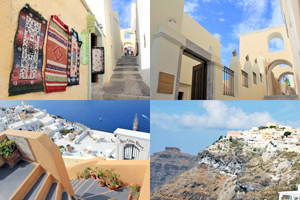
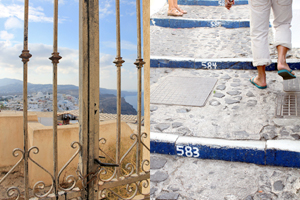 With an area of about 28 mi2 (73 km2) — just slightly bigger than half of San Francisco — Santorini is a remnant of a volcanic eruption that destroyed what used to be a single island, in the process creating the present-day caldera. Steep, high cliffs (rising up to 980 feet or 300 meters) surround a semi-rectangular central lagoon measuring roughly 7.5 by 4.3 miles (12 by 7 km) on three sides, with the main island gradually sloping downward to the Aegean Sea. Its capital, Fira, perches atop of the cliff looking down on the bay, where cruise ships and smaller boats are now a common sight. (Not a particularly unpleasant setup, especially when you're soaking comfortably in a pool, watching the Greek day go by.)
With an area of about 28 mi2 (73 km2) — just slightly bigger than half of San Francisco — Santorini is a remnant of a volcanic eruption that destroyed what used to be a single island, in the process creating the present-day caldera. Steep, high cliffs (rising up to 980 feet or 300 meters) surround a semi-rectangular central lagoon measuring roughly 7.5 by 4.3 miles (12 by 7 km) on three sides, with the main island gradually sloping downward to the Aegean Sea. Its capital, Fira, perches atop of the cliff looking down on the bay, where cruise ships and smaller boats are now a common sight. (Not a particularly unpleasant setup, especially when you're soaking comfortably in a pool, watching the Greek day go by.)
After the 1956 quake and ensuing tsunami that destroyed hundreds of structures and killed 53, Santorini's recovery was hastened by the expansion of tourism, particularly in the summer months, in turn prompting the growth of the economy and population. Santorini was ranked the world's top island for many magazines and travel sites, including the BBC, Travel+Leisure Magazine, and US News. Around two million tourists visit annually, nearly half of that arriving on cruise ships.
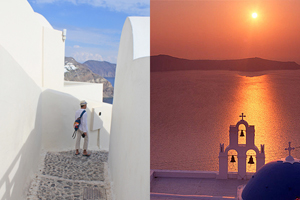
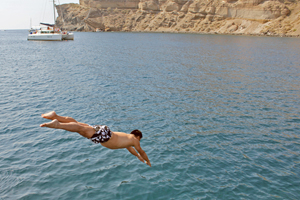 Must-dos in Santorini include sunset-watching in Oia, if you like that sort of thing, that is. Take a stroll around town while you're at it, or have dinner at any of the restaurants overlooking the Aegean Sea and the town below. You'll see the sunset either way. And speaking of dinner, try Aginares me Koukia and wash it down with a Yellow Donkey beer.
Must-dos in Santorini include sunset-watching in Oia, if you like that sort of thing, that is. Take a stroll around town while you're at it, or have dinner at any of the restaurants overlooking the Aegean Sea and the town below. You'll see the sunset either way. And speaking of dinner, try Aginares me Koukia and wash it down with a Yellow Donkey beer.
If the stroll isn't enough for you, take the hike from Oia to Fira, a good and easy six miles on comfy shoes. You can do this early in the morning or late in the afternoon to avoid the strong midday sun. From there you can head to Santo Winery for some Greek wines, olives, and small bites — before proceeding to the quaint village of Pyrgos atop a hill if only for the great views across the entire island.
Can't get enough of the walking? Climb up the 588 steps from the Old Port to Fira — make it as leisurely as you like — and enjoy the pretty sights, including the donkeys, along the way. And once in Fira, why not explore this capital city as well? Despite, or perhaps because of its small size, the city packs a wallop when it comes to breathtaking vistas, beautiful churches, and picturesque street scenes replete with cobblestone pavements and quaint nooks, shophouses, and cafes.
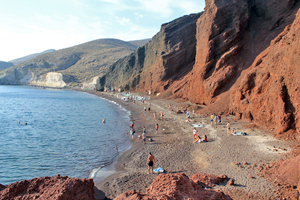
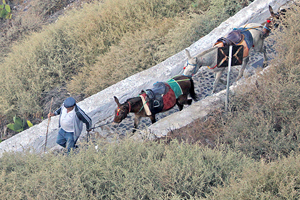 If you've just about had enough of the crowds of Oia and Fira, head next to Megalochori — where you won't find a lot of tourists — for some quality alone time. Loving the peace and quiet yet? Top this with a visit to the highest point on the island. Moni Profiti Ilia (Prophet Elias Monastery) is a solemn sanctuary atop a mountain, probably the best (and least crowded) place to catch Santorini's world-famous sunsets.
If you've just about had enough of the crowds of Oia and Fira, head next to Megalochori — where you won't find a lot of tourists — for some quality alone time. Loving the peace and quiet yet? Top this with a visit to the highest point on the island. Moni Profiti Ilia (Prophet Elias Monastery) is a solemn sanctuary atop a mountain, probably the best (and least crowded) place to catch Santorini's world-famous sunsets.
Sailing around the Agean Sea and the caldera on a yacht — it goes without saying — remains to be the highlight of any visit to Santorini. Short of hiring your own boat and captain, you can pick any of many caldera cruise tour packages available April through November. Make sure to book one that caters to only a handful of passengers, and includes a full lunch (seafood, I'd guess) in the saloon area below deck, and an open bar elsewhere, if you insist. Most yacht cruises circle the bay to show the remarkable sections of the bay and caldera, allow interested passengers to visit the volcanic island and linger for a bit in its hot springs, and encourage everyone else to soak up the sun and dive into the deep, blue Aegean Sea.
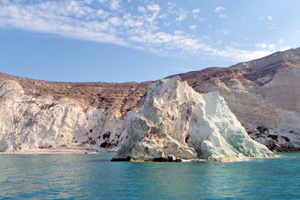
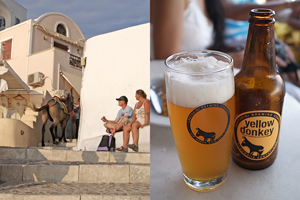 The caldera cruise gives you a glimpse of the beaches on mainland Santorini that you'd probably want to visit next. I'd recommend Ammoudi Bay, probably Santorini's best swimming spot (although not a beach) — walk down from Oia to Ammoudi Port, turn left and walk along the water's edge for a few minutes, then jump from the rocks into the aquamarine waters below — but that's risky, so I'd rather suggest Red Beach instead. On the approach the beach and its backdrop are breathtaking. On the shore the pebbly sand is mostly red. (The color of beach sand on the island depends on the geological layer exposed over time; beaches with pebbles and sand from red solidified lava include the Red Beach.) Here the water is noticeably warmer because lava absorbs heat.
The caldera cruise gives you a glimpse of the beaches on mainland Santorini that you'd probably want to visit next. I'd recommend Ammoudi Bay, probably Santorini's best swimming spot (although not a beach) — walk down from Oia to Ammoudi Port, turn left and walk along the water's edge for a few minutes, then jump from the rocks into the aquamarine waters below — but that's risky, so I'd rather suggest Red Beach instead. On the approach the beach and its backdrop are breathtaking. On the shore the pebbly sand is mostly red. (The color of beach sand on the island depends on the geological layer exposed over time; beaches with pebbles and sand from red solidified lava include the Red Beach.) Here the water is noticeably warmer because lava absorbs heat.
Did I mention that Santorini is considered an active volcano? Splendid!
First published on GruffDraft.com 24 September 2018.
 | | 
Planning a cruise, a tour for yourself and your loved one (or a big group of family and friends), or a personal pilgrimage? Maybe just seeking hotel accommodations, airline flights, travel insurance, or transportation rental? We can arrange any and all of that for you anywhere on the globe, so you don't have to do the heavy-lifting yourself. We cater to small or big groups, couples, families, and individuals — and we can tailor-fit the services just for your needs.
For more information, contact us now.
  
|